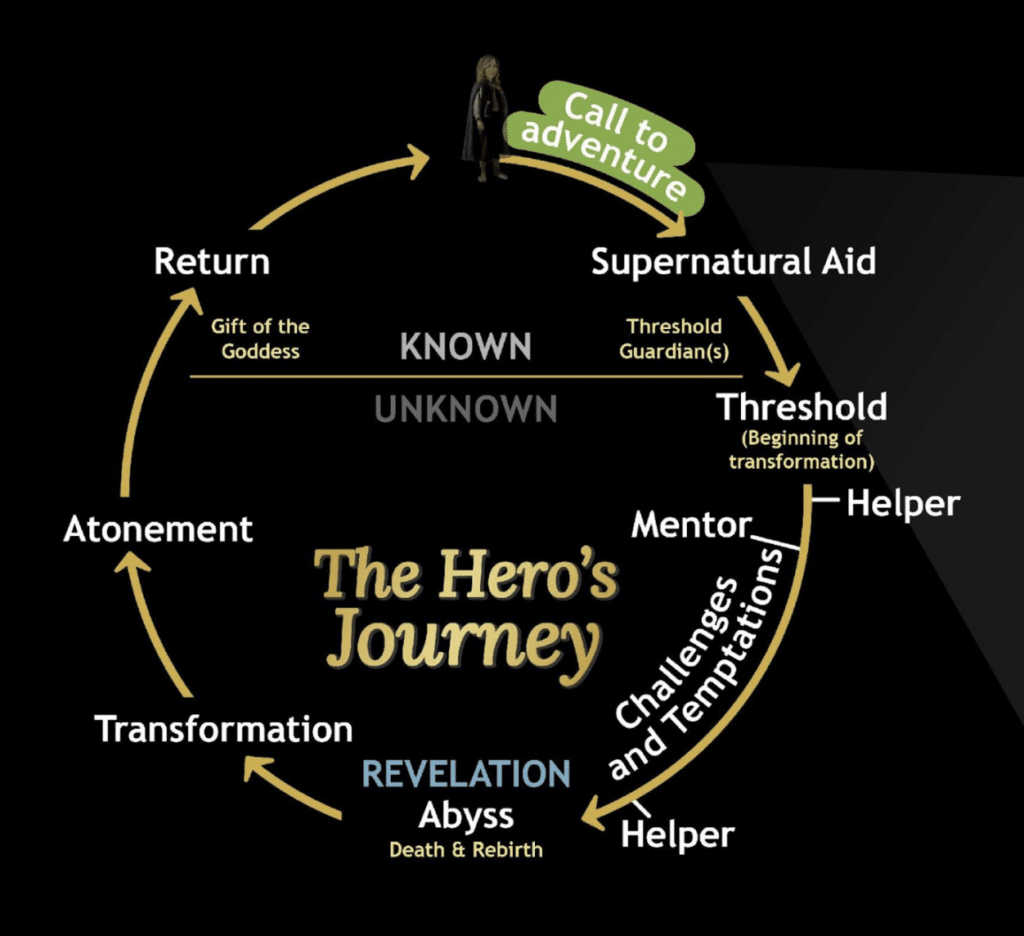This was my first year attending Social Media Marketing World in San Diego, and I certainly left with enough knowledge that my head felt like it was going to pop.
Social media is obviously changing in many ways:
- Twitter is going through all kinds of crazy updates.
- TikTok could be banned.
- The model of “walled off social media gardens” could wane in power, giving rise to a decentralized internet of the future.
Rather than going through all of the fascinating details I heard during the meeting, I want to focus in on the more strategic concept of creating a call to adventure for your audience. This idea can apply to any social media channel or website.
A Call to Action vs. A Call to Adventure
The big problem that so many companies have to fight with their messaging is that it defaults to a “me first” kind of communication. By that, I mean that the messages talk about why the company or the product is great.
Unfortunately, this message doesn’t automatically connect with an audience. How does it help the potential customer that the product or the company is great? Why does it matter?
Too often, these questions go unanswered. The company simply ends a message with a call to action on how to sign-up or buy a product.
I know I’m guilty of this kind of messaging.
The big difference between a call to action and a call to adventure is the point of origin.
If you’re starting from a company’s perspective, then you’re focused on “this is what we have to offer and what we need people to buy.”
If you’re starting with the customer’s perspective, then you’re looking at their life goals, their habits, their needs, and how a product or service might be able to assist with meeting those goals or needs.
Pretty big difference!
As marketers, we know we’re supposed to be starting from the customers’ perspective, but it’s difficult to remember in the day in and day out of getting work done.
The Hero’s Journey
A few different presenters at Social Media Marketing World made mention of the hero’s journey, which Wikipedia defines as “the common template of stories that involve a hero who goes on an adventure, is victorious in a decisive crisis, and comes home changed or transformed.”
Presenter Marley Jaxx illustrated how Frodo went on the hero’s journey. Frodo left the Shire, ultimately cast the Ring into fires of Mordor (albeit with Gollum’s inadvertent help), and came home a changed hobbit.

That said, there’s an important caveat to Frodo’s journey. He was incredibly reluctant to leave the Shire in the first place, even with the encouragement and guidance of Gandalf. Frodo was curious about life beyond the Shire, but he hadn’t gone adventuring before.
(Okay, we’re done talking about The Lord of the Rings. I promise.)
Your Role as the Mentor and Helper
When applied to the audience you’re marketing to, this means that your company can help your customer take the leap to leave the safety they already know.
Their status quo is familiar, even if it isn’t optimal.
The switching cost of moving from an old product to a new one is very high in the medical field. Sometimes you may have compelling evidence that your device will clearly have better outcomes than the old system, but the data isn’t always so obvious. Even if the outcomes are better, you may still struggle to win over some customers.
In order to encourage people to take that leap, you have to deeply understand the motivations of your customers. Factual arguments help make your point. But they can’t be the sum of what you have to say.
Your Audience’s Backstory
If you’ve been a subscriber to our newsletter, you know I’ve talked some about obsessing over your company’s audience. You can browse through some ways to research your audience’s interests, and you can read through some recommendations around engaging your customers in a community that serves their needs.
But before we even turn to these various tools, let’s just imagine a few ways customers could interact with your product.
Empowered Physicians?
Think about a physician using a particular implant. She helped provide the medical opinion for the purchasing committee for the hospital. She reviewed the available literature, tested the implant, and recommended the product highly. When the committee agreed to select the device, she felt a sense of pride at a job well done.
Maybe another physician at the same hospital is now using the same implant because he must. He wasn’t included on the buying committee, and he’s “stuck” using the one the hospital wants. He will certainly have a level of ongoing dissatisfaction with using the implant.
The second physician doesn’t have the level of empowerment he’d like. This speaks to a much different, much deeper need than just a surgical preference. He will likely be looking for a different work environment in the coming years.
For more on contributing to a physician’s call to adventure, see our expanded article on the topic here.
A Patient / Consumer’s Busy Day
Or, let’s think about a patient / consumer using a medical device at home. This individual may have even higher demands than a physician when it comes to usability.
The person using the medical device is probably not interested in all the bells and whistles on the device and the corresponding app. His top interest is being able to get on with his day so he can go to work or pursue his hobbies. Any new features that do not match his primary goal of simplicity will be dismissed out of hand.
Changing the Tone of Your Messaging
Understanding these needs and desires creates a much different way of talking about a product. It also creates a much different way of approaching social media and other messaging.
Maybe it’s less important to talk about what the product will do. It could be more important to talk about what enables physicians to complete their work safely and effectively. Patients and consumers may want to read more about how current users of your device are still able to go on to live with better mobility or how their positive health enables their interests more. Yes, your product is a part of that discussion, but it’s certainly not the whole thing.
Working Together to Shape the Messaging
In the case of the physicians above, you can see how the marketing department on its own would struggle to grab the context of who the happy customer is. While both physicians might use a device, they definitely have different sentiments toward it.
Marketing will need to work with a salesperson or someone who can have close interaction with physicians to more effectively segment customers.
For a broader user base, like in the case of patients / consumers, marketing could work with some research on what people want from their devices. They should also look to customer service and sales to see what kinds of concerns and questions people voice.
“Let’s Do This Together” Instead of “Buy Now”
When you think of embarking on a journey with someone, the process is much longer than a single purchase decision. There’s a critical trust-building phase where you establish common ground. The hero of the story (the customer) has to see that the guide is capable.
The hero also has to see the real value in leaving the comfortable to take a risk. Keep in mind with storytelling that a hero is often forced to make a change due to dire circumstances. Your customer may only take that step forward when they feel there’s no other choice OR when they feel it’s safe enough to journey forward.
It’s your job to help identify what will make the adventure compelling enough and make your guidance feel safe enough.
Recommended Resources
Rather than let this message sprawl into too many directions, I decided to create a quick guide here of other interesting topics from Social Media Marketing World.
- The Bell Feature on LinkedIn – Here’s a LinkedIn post I wrote after attending the event to explain a new feature I didn’t know about. It’s essentially a “subscribe” button to receive notifications from the people you want to see most.
- LinkedIn Advertising Podcast – We actually hired B2Linked to help us with our advertising content, so I can definitely vouch for the ideas presented here.
- Decentralized Social Media – A quick explainer of what decentralized social media is and why Twitter’s many changes is helping other platforms gain attention.
- Google Cloud Video Intelligence API – Presenter Tim Schmoyer showed a few slides demonstrating how Google uses similar technology to analyze content being loaded into YouTube to recognize people and objects and make associations between them. This page will give you a quick glimpse at what’s possible.
Michael spends a great deal of time with the healthcare industry both professionally and personally, which gives him the perspective of what stakeholders on either side of the care equation need.
He began coding in 2008 and subsequently shifted his attention entirely to online marketing. Michael completed his MBA in 2018, focusing on the intersection of healthcare and marketing.


